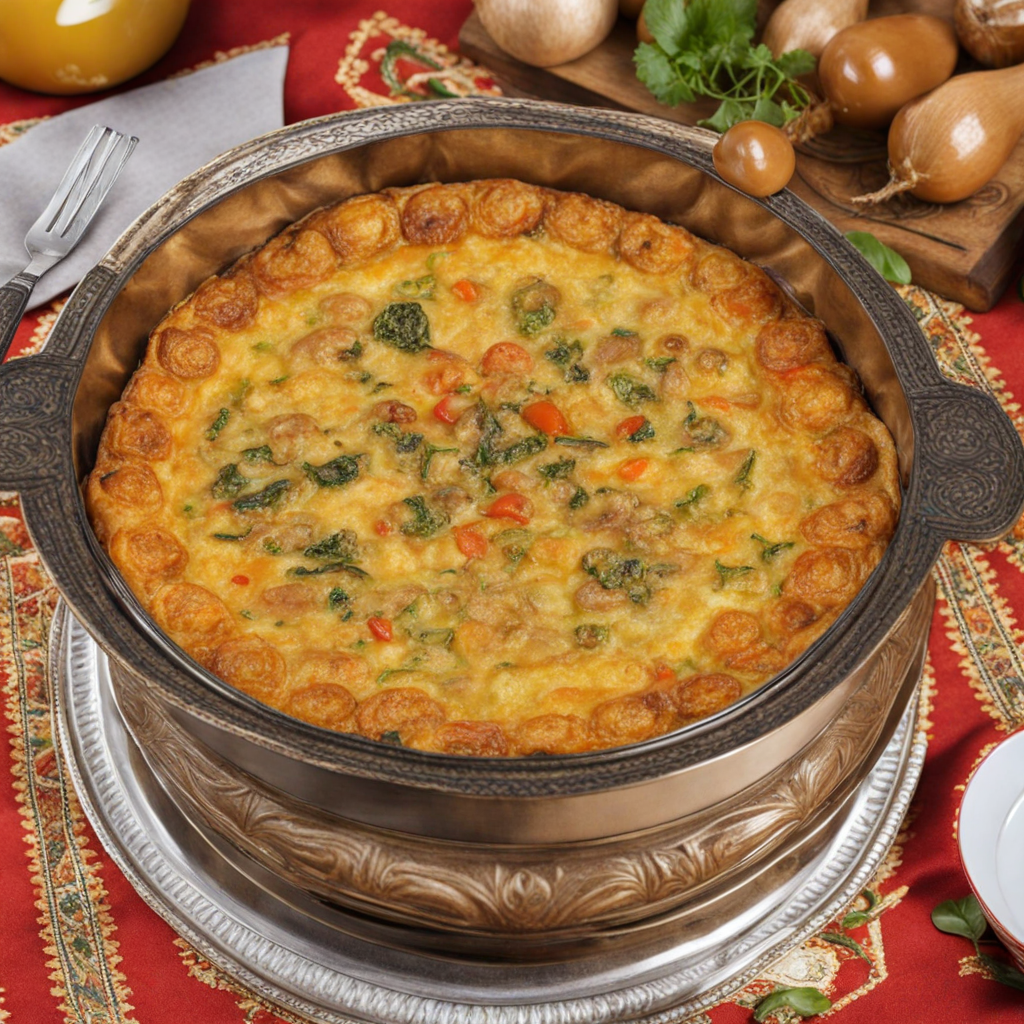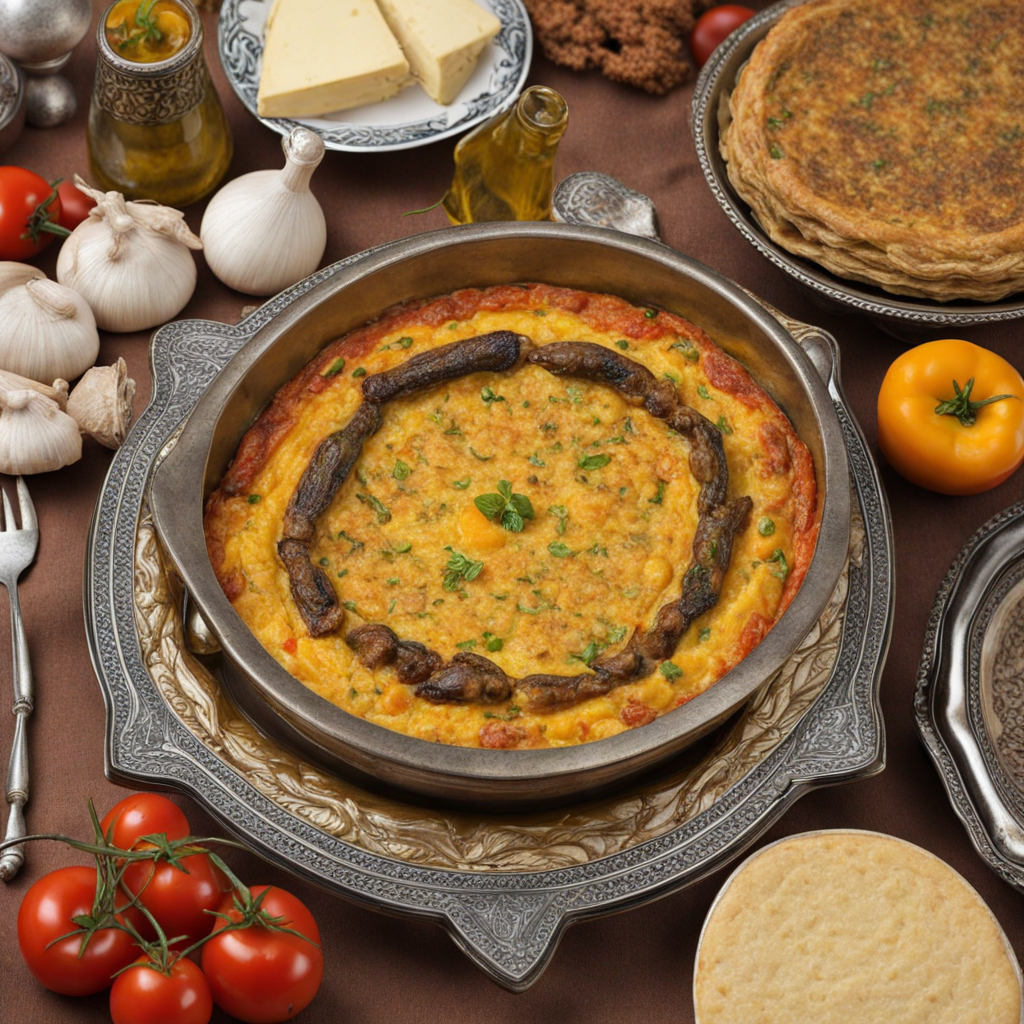Tajine
Tajine is a beloved Tunisian dish that showcases the rich culinary heritage of the region. Unlike the Moroccan tagine, which is a slow-cooked stew, Tunisian tajine is more akin to a savory pie or frittata. It typically features a base of beaten eggs mixed with a variety of ingredients such as vegetables, meats, seafood, and aromatic spices. The combination of flavors is both vibrant and comforting, making it a staple in many Tunisian households. The dish is often baked until golden brown, resulting in a crispy exterior that encases a flavorful filling, offering a delightful contrast in textures.
How It Became This Dish
The History of طاجين (Tajine) in Tunisia The culinary heritage of Tunisia is rich and diverse, deeply interwoven with the country’s history, geography, and cultural exchanges. Among the many dishes that encapsulate this heritage, طاجين (Tajine) stands out as a symbol of Tunisian gastronomy. While the name might evoke associations with Moroccan cuisine, the Tunisian version of Tajine is distinctly different, boasting its own unique flavors, ingredients, and cultural significance. #### Origins of Tajine The origins of Tajine can be traced back to the ancient civilizations that inhabited North Africa, including the Berbers and the Phoenicians. The concept of slow-cooked, seasoned food is not unique to Tunisia; it has roots in the broader Mediterranean and Middle Eastern culinary traditions. The term "Tajine" is derived from the Arabic word "طاجين," which refers to both the dish and the earthenware pot in which it is cooked. This cooking vessel has been used for centuries due to its ability to retain heat and moisture, allowing for slow cooking that enhances the flavors of the ingredients. Historically, Tunisia's strategic location along the Mediterranean trade routes has resulted in a melting pot of culinary influences. The Berbers contributed their indigenous agricultural practices and local herbs, while the Arabs introduced various spices and cooking techniques. The influence of the Ottomans, who ruled Tunisia for several centuries, also played a crucial role in shaping the country's culinary landscape. These interactions led to the emergence of a distinctive Tunisian Tajine that reflects the region’s diverse ingredients and flavors. #### Cultural Significance Tajine is more than just a dish; it is a cultural artifact that embodies the social fabric of Tunisian life. Traditionally, it is prepared for communal gatherings, family celebrations, and religious feasts, making it an essential part of Tunisia’s culinary and social traditions. In a country where hospitality is paramount, serving Tajine to guests is a gesture of warmth and generosity. In Tunisia, Tajine is often enjoyed during Friday lunches, a time when families come together to break bread. The dish carries connotations of comfort and togetherness, making it a staple during significant life events, such as weddings and religious holidays like Eid. The communal nature of the meal encourages sharing and bonding, reinforcing familial ties and cultural identity. Moreover, Tajine reflects the Tunisian way of life, characterized by a deep connection to the land and its produce. The dish varies in preparation based on the season and local ingredients, showcasing the importance of fresh, regional produce and the traditional practices of foraging and farming that have been passed down through generations. This adaptability is a hallmark of Tunisian cuisine, allowing Tajine to evolve while remaining rooted in its cultural significance. #### Development Over Time The evolution of Tajine in Tunisia has been marked by the interplay of tradition and innovation. While the essential components of the dish—usually a combination of proteins (like chicken, lamb, or fish), vegetables, and a binding agent—have remained largely consistent, the flavors and preparations have diversified over time. Traditionally, the ingredients were dictated by what was locally available. For instance, in coastal regions, seafood Tajine is popular, featuring fresh fish and shellfish, while inland areas favor meat-based Tajine, often incorporating local vegetables such as potatoes, carrots, and peas. The use of spices, such as cumin, coriander, and saffron, also varies by region, reflecting local palates and culinary customs. The binding agent in a Tunisian Tajine distinguishes it from its Moroccan counterpart. While Moroccan Tajine often relies on a sauce or stew-like consistency, Tunisian Tajine is frequently thickened with eggs, flour, or breadcrumbs, resulting in a texture reminiscent of a frittata or a quiche. This adaptation has made Tajine a versatile dish suitable for any meal of the day, from breakfast to dinner. In the 20th century, as Tunisia underwent social and political changes, the culinary landscape began to reflect new influences. The arrival of French colonialism brought a wave of new ingredients and cooking techniques, leading to further diversification of Tunisian Tajine. Chefs began to experiment with a fusion of flavors, incorporating elements from French cuisine while maintaining the essence of traditional recipes. The globalization of food culture in recent decades has also impacted the way Tajine is perceived and prepared. As travel and media exposure introduced international culinary trends to Tunisia, chefs began to reinterpret traditional Tajine, infusing it with modern techniques and presentations. This innovation has led to a resurgence in the popularity of Tajine, both locally and among international food enthusiasts. #### Contemporary Tajine Today, Tajine occupies a prominent place in Tunisia’s culinary landscape, celebrated in both home kitchens and restaurants. It is not uncommon to find variations of Tajine on menus that cater to contemporary tastes, such as vegetarian options or Tajine with international influences, showcasing global ingredients alongside traditional flavors. Food festivals and culinary events in Tunisia often feature Tajine as a centerpiece, highlighting its significance as a symbol of national pride and cultural identity. Chefs and home cooks alike are dedicated to preserving the traditional recipes while experimenting with new variations, ensuring that Tajine remains relevant in an ever-changing culinary scene. Moreover, the rise of social media has played a role in popularizing Tajine beyond Tunisia's borders. Food bloggers and influencers showcase the dish in visually appealing ways, sharing recipes and stories that celebrate its rich heritage. This visibility has fostered a renewed interest in Tunisian cuisine, inviting people from all corners of the globe to explore and appreciate the complexities of Tajine. #### Conclusion Tajine is more than just a dish; it is a narrative of Tunisia’s history, culture, and culinary evolution. From its ancient origins to its contemporary interpretations, Tajine embodies the essence of Tunisian hospitality and the importance of family and community. As it continues to evolve while honoring its roots, Tajine remains a beloved staple in Tunisian households and a source of pride for the nation's rich culinary heritage. The dish serves as a delicious reminder of the interconnectedness of food, culture, and identity, celebrating the flavors of Tunisia for generations to come.
You may like
Discover local flavors from Tunisia







